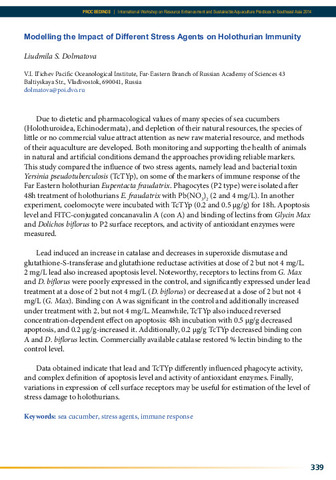Modelling the impact of different stress agents on Holothurian immunity
Share
Abstract
Due to dietetic and pharmacological values of many species of sea cucumbers (Holothuroidea, Echinodermata), and depletion of their natural resources, the species of little or no commercial value attract attention as new raw material resource, and methods of their aquaculture are developed. Both monitoring and supporting the health of animals in natural and artificial conditions demand the approaches providing reliable markers. This study compared the influence of two stress agents, namely lead and bacterial toxin Yersinia pseudotuberculosis (ТсТYp), on some of the markers of immune response of the Far Eastern holothurian Eupentacta fraudatrix. Phagocytes (P2 type) were isolated after 48h treatment of holothurians E. fraudatrix with Pb(NO3)2 (2 and 4 mg/L). In another experiment, coelomocyte were incubated with ТсТYp (0.2 and 0.5 µg/g) for 18h. Apoptosis level and FITC-conjugated concanavalin A (con A) and binding of lectins from Glycin Max and Dolichos biflorus to P2 surface receptors, and activity of antioxidant enzymes were measured.
Lead induced an increase in catalase and decreases in superoxide dismutase and glutathione-S-transferase and glutathione reductase activities at dose of 2 but not 4 mg/L. 2 mg/L lead also increased apoptosis level. Noteworthy, receptors to lectins from G. Max and D. biflorus were poorly expressed in the control, and significantly expressed under lead treatment at a dose of 2 but not 4 mg/L (D. biflorus) or decreased at a dose of 2 but not 4 mg/L (G. Max). Binding con A was significant in the control and additionally increased under treatment with 2, but not 4 mg/L. Meanwhile, ТсТYp also induced reversed concentration-dependent effect on apoptosis: 48h incubation with 0.5 µg/g decreased apoptosis, and 0.2 µg/g-increased it. Additionally, 0.2 µg/g ТсТYp decreased binding con A and D. biflorus lectin. Commercially available catalase restored % lectin binding to the control level.
Data obtained indicate that lead and ТсТYp differently influenced phagocyte activity, and complex definition of apoptosis level and activity of antioxidant enzymes. Finally, variations in expression of cell surface receptors may be useful for estimation of the level of stress damage to holothurians.
Description
Abstract only.
Suggested Citation
Dolmatova, L. S. (2015). Modelling the impact of different stress agents on Holothurian immunity. In M. R. R. Romana-Eguia, F. D. Parado-Estepa, N. D. Salayo, & M. J. H. Lebata-Ramos (Eds.), Resource Enhancement and Sustainable Aquaculture Practices in Southeast Asia: Challenges in Responsible Production of Aquatic Species: Proceedings of the International Workshop on Resource Enhancement and Sustainable Aquaculture Practices in Southeast Asia 2014 (RESA) (p. 339). Tigbauan, Iloilo, Philippines: Aquaculture Department, Southeast Asian Fisheries Development Center.

